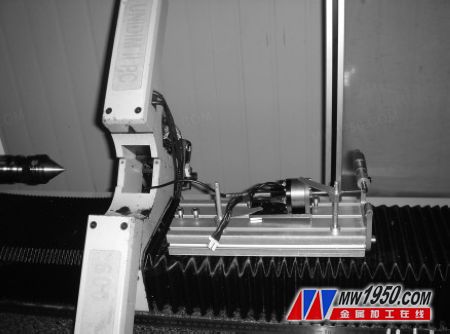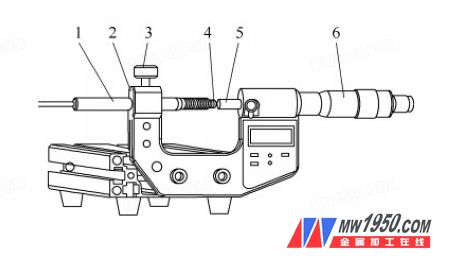(1) Fault diagnosis of on-line coordinate measuring machine measuring head displacement sensor The two-coordinate measuring machine is a high-precision, high-flexibility, high-efficiency size and shape integration widely used in the production of shaft parts for engines and transmissions. On-line inspection equipment, once an on-line coordinate measuring machine used by our factory to detect one axis of the gearbox has intermittent failure of the stylus in the Y-axis during normal operation. We use the displacement sensor to repair the diagnostic device. The cause of the failure was quickly detected and the targeted maintenance adjustment was made, and the equipment function was restored in time. Figure 1 is the installation picture of the displacement sensor maintenance diagnostic device when checking the online two-coordinate sensor failure.

Diagnostic device check online two-coordinate sensor fault installation
The accuracy requirement of the testing equipment is: the sensitivity of the Y-axis measuring head should be 0.001 mm of the contact movement, 0.080 mm on the interface of the device, and the trigger distance of the micro-distance anti-collision switch is (0.50±0.02) mm. The sensor protection is effective. The sex is checked from the four micro-range potential switches, which is difficult to achieve by ordinary inspection methods.
The displacement sensor diagnostic device checks the fault process of the on-line coordinate measuring machine sensor. As shown in FIG. 3, the measuring head 5 is removed from the coordinate machine guide rail, and the backing plate 1 is placed on the upper surface of the small platform base 2, and the position is adjusted. The measuring contact 6 is substantially in contact with the center of the end surface of the micrometer measuring rod 7, and the sensor cable on the measuring head 5 is inserted on the corresponding instrument for easy observation of the change of the indication value, and the pressure plate guide rod + nut 3 is mounted on the small platform base 2 In the T-shaped groove, the elastic pressure plate 4 is sleeved on the pressure plate guide rod + nut 3. The appropriate position is selected to contact the measuring head 5, and the elastic pressing plate 4 is pressed down by hand to complete the pressing. The rotary micrometer differential cylinder 8 compares the value displayed on the digital micrometer with the value on the gauge, and repeats the operation to check the repeatability. Sensitivity check According to the technical requirements of the equipment, by rotating the micrometer differential cylinder 8, the measuring contact 6 is moved by several values, the values ​​and deviations displayed on the instrument connected to the measuring head 5 are checked, and the sensor amplifier board in the driving box is adjusted to meet the requirements. Check the linearity within the working range afterwards.

Diagnostic device checks online two-coordinate sensor fault process
1. Backing plate 2. Small platform base 3. Pressure plate guide rod + nut 4. Elastic pressure plate 5. Measuring head
6. Measuring contacts 7. Micrometer measuring rod 8. Micrometer differential tube
Check and adjust the 4 micro-distance switches to remove the 6-pin plug connector on the measuring head, use a multimeter to switch to the resistance-on-off gear, and the test leads are in contact with the pins. The measuring heads are clamped from 4 different directions to make the measurement. The ruby ​​on the stylus is in critical contact with the micrometer. Rotate the micro-cylinder on the micrometer to observe the trigger signal and the reading on the micrometer. Adjust the trigger distance of the anti-collision switch as required.
After checking by the diagnostic device, it is found that the sensitivity of the displacement sensor on the Y-axis measuring head is low, and the sensitivity of the four micro-miniature anti-collision switches in the Y-axis measuring head is invalid and needs to be adjusted.
(2) Crankshaft connecting rod grinding machine Active measuring instrument probe sensor accuracy inspection Diagnosis Active measurement refers to the automatic completion of the detection of the relevant parameters of the machined parts in the machining process, and feedback the measured results to the processing system in time. An active detection method that continuously corrects and controls the machining state to achieve the predetermined quality requirements. The measuring device used for active measurement is called the active measuring instrument, and has been widely used in the grinding of shaft parts for automotive parts. . There is a Japanese NTC double-grinding crankshaft connecting rod neck tracking grinding machine on the L2 line of Shenlong Xiangyang Machine Processing Factory. The grinding allowance is measured by the active measuring device - MARPOSS UNIMARR20 measuring head, which often has unstable processing dimensions. The phenomenon is superficially caused by the unstable operation of the measuring instrument. We removed the MARPOSS measuring head from the equipment and placed it on the diagnostic device for on-site inspection and tracking. It was found that the measuring head of the residual distributor worked stably and there was no There is drift.
The displacement sensor diagnostic device checks the accuracy of the sensor of the grinder active measuring probe. As shown in Fig. 4, the MARPOSS measuring head 3 is removed from the device and placed on the measuring head or the sensor holder 4, and the measuring position is adjusted to make the measuring contact 6 and the micrometer. The center of the end surface of the measuring rod 7 is substantially in contact, and the sensor cable on the measuring head 3 is plugged into its corresponding instrument for easy observation of the change of the indication value. The sensor holder 4 is fixed on the top of the base 1 by screws + nuts 2, and the rotation is locked. The screw 5 fixes the measuring head 3, and the rotary micrometer differential cylinder 8 compares the value displayed on the digital micrometer with the value on the measuring instrument, and repeats the operation to check the repeatability. The linear inspection can be performed by rotating the micrometer differential cylinder 8 to move the measurement and contact 6 by a value, and to view and compare the values ​​and deviations displayed on the instrument connected to the on-line two-coordinate measuring head. If necessary, the micrometer can be rotated by the micrometer. Directly read out the measuring range and total mechanical travel of the measuring head; at the same time, the function of the pneumatic probe or the electromagnet pull on the active measuring instrument can be used to check the repeatability of the measuring head sensor. The difference and the result are on the measuring instrument. Read and then compare to the micrometer reading.

Diagnostic device to check the accuracy of the sensor of the grinder active measuring instrument
1. Base 2. Screw + nut 3. Measuring head 4. Sensor mounting bracket 5. Locking screw
6. Measuring contacts 7. Micrometer measuring rod 8. Micrometer differential tube
After using the diagnostic device to simulate the working condition of the measuring instrument, the measuring contact and the end face of the micrometer measuring rod are in contact with the indication value change on the instrument in the observation device, and the result is stable, which proves that the measuring head sensor of the residual distributor has no problem, The results of our tests were fed back to the field equipment for maintenance, and the maintenance direction was adjusted in time. Finally, it was found that the hydraulic components in the tailstock of the processing equipment caused the crankshaft displacement.
(3) Pen-shaped probe sensor for online detection equipment Accuracy inspection and diagnosis The pen-shaped sensor is a kind of probe sensor which is widely used in online detection equipment. When the on-line detection equipment has measurement accuracy problem, it must firstly be applied to the pen-shaped probe sensor. Check and diagnose linearly and reproducibly.
Using the diagnostic device to check the accuracy of the pen-shaped sensor of the online detecting device, as shown in the figure, the pen-shaped sensor 1 is mounted on the mounting frame 2, the sensor is fixed by the locking screw 3, and the measuring contact 4 is adjusted to contact the end surface of the micrometer measuring rod 5, the sensor The cable of 1 is plugged into its corresponding instrument to facilitate observation of the change of indication value. The rotary differential cylinder 6 compares the value displayed by the digital micrometer with the value on the measuring instrument, and repeats the operation to check the repeatability. This type has a pneumatic The function-driven sensor uses the pneumatic push function for repeatability check; the linear check is to rotate the micrometer differential cylinder 6 to move the measuring contact 4 to multiple values, and to view and connect the instrument connected to the online two-coordinate sensor. The values ​​and deviations shown above are evaluated by at least 5 deviation values ​​to determine whether the linearity of the sensor meets the accuracy requirements.

Diagnostic device checks the accuracy of the pen-shaped sensor on-line detection equipment
1. Pen sensor 2. Mounting bracket 3. Locking screw
4. Measuring contact 5. Micrometer measuring rod 6. Differential tube
It should be noted that the digital micrometer used in the displacement sensor diagnostic device is periodically verified to ensure the accuracy and reliability of the diagnostic device.
Torque Hinges,Constant Torque Hinge,Adjustable Torque Hinge,Torque Door Hinges
Ningbo Hengchieh Locking Technology Co., Ltd. , http://www.hengchieh.com